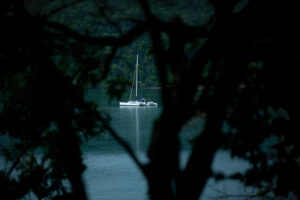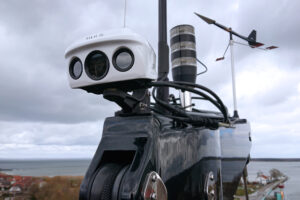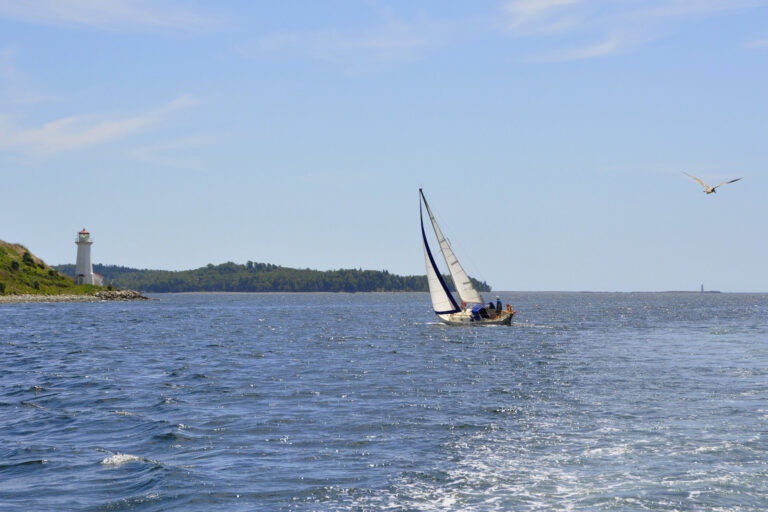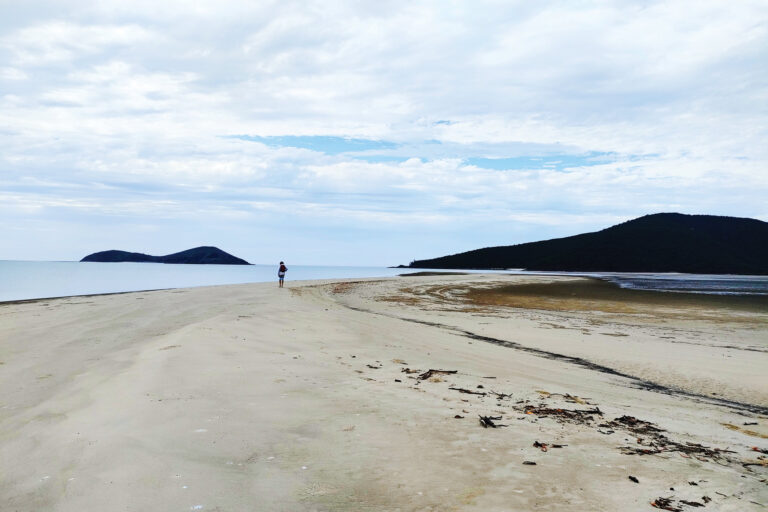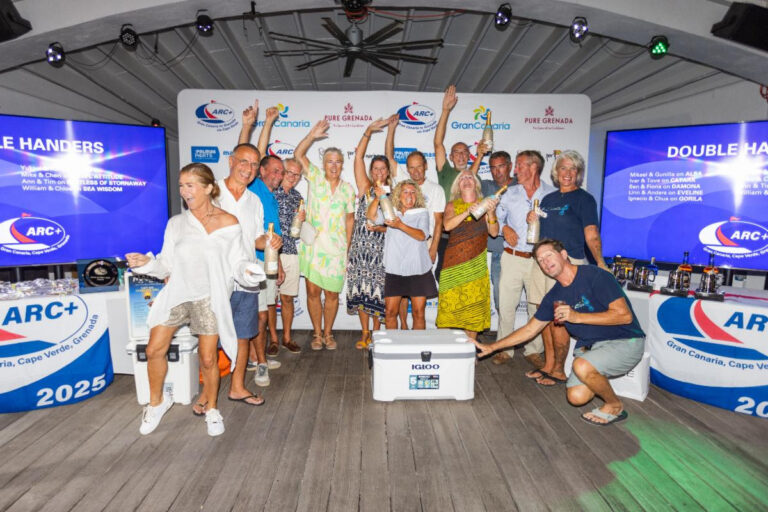
You can’t help but like a boat that balances off the wind as well as it does close-reaching. And for true long-term cruising, a boat that packs a tremendous payload not only extends your range but also opens all kinds of options when you finally get where you want to be.
For these and other reasons, I quickly grew attached to the Island Packet 485, a 20-ton, 51-foot-LOA center-cockpit sloop that’s as well mannered as it is amply proportioned. I sailed the 485 this winter in the Atlantic waters off of Miami, where it didn’t take much imagination to envision an open-ended cruise that could last for years. Although notably bigger than any Island Packet to date, the 485’s 5-foot-3-inch draft and 63-foot-6-inch mast height make it as adept at exploring the Intracoastal Waterway as it is pointing its bow toward Tahiti.
In its 25 years, Island Packet has been highly regarded for building strong, seaworthy sailboats that are tuned to the cruising sailor’s needs. With first-rate systems and enough storage space to keep a cruising family comfortable for months at a time, the 485 is a well-appointed escape pod. No, you won’t shatter any speed records round the buoys, but the boat fits the bill for the couple or family looking for a boat that they could truly call a home.
The first center-cockpit model to come out of Island Packet’s factory in Largo, Florida, the 485 doesn’t veer from the Island Packet philosophy. The boat’s cruiser-friendly attributes include what Island Packet president and designer Bob Johnson calls a “full foil keel,” a full keel with a hydrodynamic profile to generate lift, and a heavily reinforced integral bow pulpit. These features, along with the Hoyt staysail boom and the traditional buff color are among the most recognizable features of modern Island Packets.
Hull number one, Dancing in the Dark, which our Boat of the Year judges inspected, proved her mettle straight out of the factory, taking second in her class in the 2002 Caribbean 1500. A full report of the boat’s performance in the ocean rally from Virginia to Tortola appears on the Caribbean 1500 website (www.carib1500.com/c1500/
2002.htm).
Apart from the center cockpit and a flatter sheer line, the 485 makes few significant changes to the Island Packet look. Teak caprail, step pads, and handholds give the boat a traditional accent. Whitewater Marine stainless-steel ports accentuate this salty look, although Boat of the Year judges recommended that the interior frames be through-bolted instead of screwed into a plywood backing plate. The builder points out that the installation, which is sealed with an adhesive, meets European Union requirements for Category A ocean sailing and that the company’s installed roughly 20,000 of them with this method without a failure or other problem.
On Deck
The 485 takes advantage of the center cockpit by leaving the fantail unobstructed, providing an ideal place for stowing a dinghy (up to a length of 10 feet 6 inches) on deck. A clever boom extension allows one person to lift the dinghy onto the deck and position it.
A deck hatch amidship in the fantail opens to a lazarette the size of a New York studio apartment. Not only does this space afford excellent access to the 2-inch-diameter stainless-steel rudderstock for inspection; it’s also big enough to hold a second roll-up dinghy, dive gear, surfboards, a ton of rode, and on and on. A stamped stainless-steel plate at the bottom of the ladder to this compartment offers sure footing and protects the gelcoat from the various items that will surely get dropped into this well.
On either side of this huge compartment are two gasketed hatches with overboard drains, one of which is dedicated for holding two 10-pound propane tanks. The boat I sailed had a loop in the propane-locker drain line, an oversight that was later corrected. In the event of a gas leak, the loop could allow leaking gas to settle in the line, posing a potential fire hazard.
The deep cockpit is two steps up from the deck. Well-placed teak pads ease this transition. The cockpit’s 7-foot-long seats allow plenty of room to stretch out. Cockpit stowage includes a spacious locker for a valise-packed eight-man life raft. Movement forward and around the wide side decks was satisfactory. The stainless-steel mast pulpits offer something to brace against while tending halyards, but the tight squeeze makes winch operation unnatural. Also, the top corners of these bars have protruding end caps at kidney height; smooth curved corners would solve this.
Forward of the mast, Island Packet’s rugged bowsprit and anchoring setup is bigger and beefier than previous models. The broader bow pulpit and small sprit keep anchors and tackle from banging topsides as they rattle and clang aboard, and the huge divided locker allows ample room for tackle, chain, and rode.
The staysail on the Hoyt boom offers the benefits of self-tacking and roller furling and remedies some of the trimming problems associated with a traditional club-footed staysail. The two-spreader mast has an after-intermediate shroud to counteract loads on the staysail stay. A belts-and-suspenders approach for extreme conditions would include running backstays for this service as well, although Island Packet reports its design team has carefully engineered the mast section to eliminate this need. All shrouds may be adjusted at deck level. The double backstay not only provides an extra measure of mast protection but also allows easy access to the transom swim platform.
The roller-furling headsail is sheeted to the gunwale outside of the shrouds. This wide sheeting base impacts the boat’s ability to point, but bashing to windward in record time isn’t usually high on the list of a cruiser’s priorities. In the light conditions off of Miami, the boat tacked through about 100 degrees, an angle that I’d expect to improve in more breeze.

Storage Galore
For a person who has trouble deciding what he can live without, the 485 eases the transition to living aboard. From the convenient wet locker at the base of the companionway to the linen bins below the berths, thoughtfully designed storage space turns up at every corner. And if you intend to telecommute from faraway ports, the standard layout of the 485 features a spacious office just forward of the mast to starboard. There is a dedicated space for an optional washer/dryer, and I could imagine the office being used as a small workshop, as well. Upper and lower bunk berths are also an option here.
Naturally lit by the large windows in the raised deck, the main saloon is flanked by settees on either side and a table that drops down from the bulkhead. A stowaway coffee table can be mounted on either side of the main saloon. At sea, either table would provide another handhold for moving fore and aft, essential in such a spacious cabin.
My favorite spot in the boat was the navigation station, which features a plush, high-back chair upholstered in Ultra-Leather and a full-size chart table. Ample vertical space surrounds the navigation station for mounting electronics. As Carol Hasse, one of the BOTY judges, observed, “This was obviously set up with long passages in mind.”
The fore-and-aft galley is two steps down to starboard, so the cook is near eye level with those sitting in the main cabin. With twin deep sinks, Corian countertops, and a fail-safe manual pump to back up the pressure system, the galley is well set up for cruising. One detail I liked was the small Isotherm pullout drawer on the reefer, which allows discreet access to cold drinks when the cook is busy with the counterspace over the top-loading fridge or freezer. Three opening ports over the galley provide ample ventilation. Functional, nonslip fiberglass is employed for the cabin sole in the fore and aft heads, the galley, below the companionway, and at the nav station. The main saloon and cabins have soles of teak and holly veneer.
The aft cabin features a spacious athwartship island berth, with an overhead hatch, two cowl vents, and opening ports. A hanging locker, armchair, and a spacious head with separate shower round out the arrangements. A small door leading aft from the cabin opens to the large lazarette. This lets you access the super-lazarette “garage” when the dinghy is stowed and covering the deck hatch. As one would expect of a Florida builder, ventilation on this boat is excellent, and integral shades on all hatches and windows keep the main cabin from turning into a solar cooker.
Under Way
In light air, the engine, a 100-horsepower turbochar-ged Yanmar, will be the ticket. And with 300 gallons of fuel at your disposal, you’ll have sufficient range for motoring. Under power, the boat cruised at 7.6 knots at 3,000 rpm and responded well to the helm. Backing does introduce some prop walk, but not as much as I expected with the long keel. For those who frequently lie dockside, the optional bow thruster is worth considering. The boat registered relatively high engine noise in the aft cabin during our Boat of the Year tests, but Island Packet has since fixed that by adding insulation, reducing vibration, and installing a sound barrier beneath the cabin sole. Engine noise was within the normal range during my sail.
Off the wind in light air, an asymmetric cruising spinnaker will help get the boat on her feet. By the end of our sail, the southeast sea breeze had filled in to about 12 knots, and the IP 485 footed along quite nicely, holding about 5.6 knots on a reach. In-mast roller furling, well-placed winches (three of which are electronic), and convenient sheeting made sail adjustments a snap. As the boat came alive, I let go of the wheel as the boat tracked west without wavering. She sailed that way for 10 long minutes, and she probably would have kept going had I let her. And I would’ve, except for one sad detail: a large continent between Tahiti and me.
Certainly, you don’t have to cross an ocean to appreciate all the Island Packet 485 has to offer. This is a true liveaboard long-range cruiser that will please her owners wherever they decide to drop the hook. She reminds us why full-keeled heavy-displacement boats still make sense on the world’s oceans. When a steady trade finally takes a firm hold of the port quarter, slightly overtrim the staysail, let go of the wheel, and you’ll see for yourself: For the offshore cruiser who wants room to stretch, the IP 485 offers a healthy balance.
Darrell Nicholson is Cruising World’s senior editor.
Island Packet 485 Specs
LOA 51′ 7″ (15.72 m.)
LWL 43′ 2″ (13.16 m.)
Beam 15′ 4″ (4.67 m.)
Draft 5′ 3″ (1.60 m.)
Sail Area (working) 1,267 sq. ft. (118 sq. m.)
Displacement (light) 39,000 lb. (17,690 kg.)
Ballast 16,000 lb. (7,258 kg.)
Ballast/Disp. .41
Disp./L 216
SA/Disp. 17.6
Water 340 gal. (1,287 l.)
Fuel 300 gal. (1,135 l.)
Mast Height 63′ 6″ (19.35 m.)
Designer Bob Johnson
Price (sailaway) $600,000
Island Packet Yachts
(727) 535-6431
www.ipy.com


